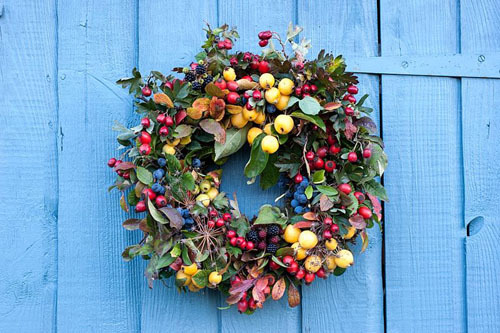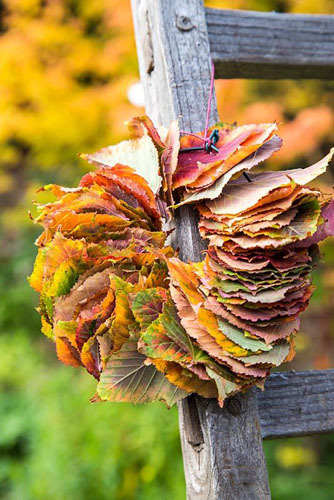The weather was very mild in late November and early December, after an early cold snap, so fall clean-up chores extended into the holiday-decorating-of-containers season this year. I realized that some of the stuff I was “cleaning up” could be used to decorate the containers or added to wreaths. My favorite garden pictures website is GAP Photos (www.gapphotos.com) – it’s a British site and always features projects that can be done with natural materials. Here are a few of the wreath ideas that were on their blog this winter:

'Hedgerow" wreath
This one they call the “hedgerow” wreath. Since I am dedicated to the proposition of creating hedgerow-like plantings for any of my clients who are willing, this showed me how beautiful the fruits of a hedgerow can be (for people). Of course, birds and animals love hedgerows too. This wreath has
Malus
(crabapples),
Crataegus
(hawthorn),
Rosa
(rose hips) and
Rubus
(blackberry) and some other types of dried seedheads.
Features of a Hedgerow
Most hedges in Britain were originally planted to keep grazing animals contained. They include one or several shrub species, often planted on a bank or with an adjacent ditch. Mixed hedgerows may include tree and shrub species such as hawthorn, hazel (
Coryllus avellana
), Field maple (
Acer campestre
), and oak. An “American” version might include serviceberry (
Amelanchier
), paperbark maple (
Acer griseum
) (for a beautiful winter bark), corneliancherry dogwood (
Cornus mas
) and shrubs like highbush blueberry (
Vaccinium corymbosum)
, red-twig dogwood (
Cornus sericea
), bloodtwig dogwood (
Cornus sanguinea
), smokebush (
Cotinus coggygria
) or ninebark (
Physocarpus opulifolius
). You could plant
Corylus colurna
(Turkish hazel) instead of
Corylus avellana
(hazel as in hazel nuts). I’ve also planted giant dogwood (
Cornus controversa
) and pagoda dogwood (
Cornus alternifolia
) in a “hedgerow” (I call it a mixed screening border). For a little pizazz you could add a crapemyrtle (
Lagerstromia
). Mix in a few evergreens like American holly (
Ilex opaca
), Oriental spruce (
Picea orientalis
) and slow-growing blue spruce (
Picea pungens
‘Fat Albert’).
Habitat for wildlife
Tall, wide and bushy hedges with several different plant species provide the richest wildlife habitats. The thick vegetation they offer gives shelter to nesting and hibernating animals while hedgerow flowers, fruits and nuts are a food source for invertebrates, birds and small mammals. Hedges act as corridors for small creatures to travel along under protective vegetation.
Some additional wildlife-friendly and/or sustainability-friendly wreath ideas:
Crabapples wired together in a circle

Maple leaves or other colored fall leaves wired into a circle.

You can cut a few stems of red-twig dogwood and winterberry holly to stuff into your containers. If you prune your magnolias, you can use their branches in containers as well. I’ve put dried-on-the-shrub hydrangeas that have nice colors into windowboxes and containers as well.
At my house I added a bittersweet-from-the-roadside wreath on the gate and red-twig and yellow-twig dogwood stems with winterberry holly stems in the containers. I also have the beautiful winter silhouette of climbing hydrangea that “camouflages” part of the dreaded chain-link fence.